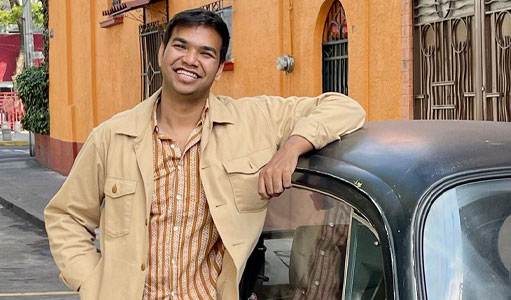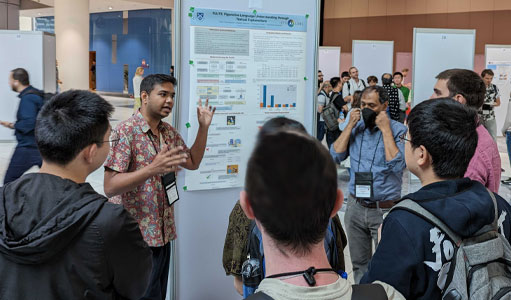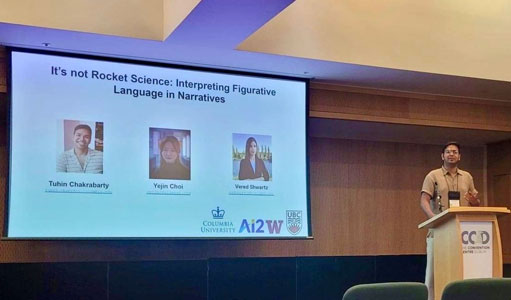Voices of CS: Tuhin Chakrabarty
PhD student Tuhin Chakrabarty talks about how his research is tapping into the creative side of computer science.
The field of natural language processing (NLP) has ramped up by leaps and bounds. This branch of artificial intelligence focuses on the ability of computers to understand and process language as humans do. It has been in the news these past few months because of a chatbot, ChatGPT, that can provide answers and data conversationally. The technology gives us a taste of just how powerful and useful NLP can be.
Tuhin Chakrabarty wants to see how much further he can push NLP in the field of computational creativity to see how computers can generate creative output. This is what ChatGPT had to say about computational creativity:
Computational creativity is a field that uses computational methods to simulate and enhance human-like creativity, producing valuable outputs such as art, music, stories, and scientific discoveries. It aims to understand and replicate the cognitive processes involved in human creativity, combining techniques from AI, cognitive psychology, and philosophy. Examples of computational creativity include generative art and music, game design, natural language processing, and scientific discovery. Ultimately, computational creativity seeks to leverage computers and algorithms to augment and extend human creativity, creating new possibilities for creative expression and innovation.

“Generating text beyond a few sentences was almost very difficult two years ago, but things look much better now. It is not perfect, but I am optimistic,” said Tuhin Chakrabarty, who first became interested in computational creativity in 2019. “One of the things that I am excited about is how better we can align models like ChatGPT to human expectations and different cultures.”
Instead of creating text conversationally, Chakrabarty’s research focuses on how AI can be used to create metaphors and detect sarcasm with little to no training data. The fifth-year PhD student advised by Smaranda Muresan has expanded his work to generating long narratives of 2,000-word documents and visual metaphors. We recently sat down with him to learn more about his research and the creative possibilities of NLP.
Q: You mentioned that you became interested in doing research during your MS. What happened that made you interested in doing research?
I did not have much research experience as an undergrad. I got accepted to the CS masters program and I was fortunate enough to take a class offered by my advisor Smaranda Muresan, which still happens to be one of my all-time favorite courses at Columbia. Computational models of Social Meaning was a graduate seminar course about impactful papers in NLP. Reading all the papers in that class made me think about what I want to do with NLP and how so many interesting research questions can be answered computationally by studying language. Alongside this, I was also working with my advisor and my friend Chris Hidey on extracting arguments from social media. That experience was really precious. The enthusiasm everyone shared in trying to solve the problem at hand made me sure of my decision to pursue research.
Q: How did you become interested in computational creativity? And what is it?
Around 2019, Nanyun Peng and He He, two very important researchers in the field of computational creativity, wrote a paper on generating puns. I happened to attend NAACL 2019 in Minneapolis, where the paper was presented. I thought the paper was beautiful in every possible way and it quantified the surprisal theory in humor algorithmically. This made me really fascinated about how we can use inductive biases to help machines generate creative output. For selfish reasons, I reached out to Nanyun Peng and told her that I wanted to work with her. She was very kind and agreed to mentor me. My PhD advisor Smaranda Muresan is one of the experts in the field of Figurative Language, which deals with creativity. So, of course, that influenced my decision to work in computational creativity too.
Computational creativity is a multidisciplinary endeavor located at the intersection of artificial intelligence, cognitive psychology, philosophy, and the arts. The goal of computational creativity is to model, simulate or replicate creativity using a computer to achieve one of several ends:
- To construct a program or computer capable of human-level creativity.
- To better understand human creativity and formulate an algorithmic perspective on human creative behavior.
- To design programs that can enhance human creativity without necessarily being creative themselves.
Q: How can you train a model or algorithm to interpret creativity or language?
State-of-the-art models are often found to be inadequate for creative tasks. The principal reason for this is that in addition to composing grammatical and fluent sentences to articulate given content, these tasks usually require extensive world and common sense knowledge.
It should also be noted that current approaches to text generation require lots of training data for supervision. However, most existing corpus for creative forms of text is limited in size. Even if such a corpus existed, learning the distribution of existing data and sampling from it is unlikely to lead to truly novel, creative output.
So we have to rely on unsupervised or weakly supervised techniques to train an end-to-end model to interpret or generate creative text. Of course, with the advent of Large Language Models and few-shot learning, we can now prompt a model with a few examples of creative text and it can somewhat generalize (but not as well as humans). My dissertation deals with a lot of this.

Q: Let’s talk about your work with the New York Times. What type of research questions did you have to answer while there? How was it different from what you have been doing?
Over the past several years, a key focus for NYTimes Research and Development has understood how advances in machine learning can extend the capabilities of journalists and unlock reader experiences that aren’t possible today. Questions and answers are central to how humans learn. Times journalism frequently uses FAQ and Q&A-style articles to help readers understand complex topics like the Covid-19 vaccines. To enhance this style of journalism, we experimented with large language models to match questions to answers, even if the reader asks their question in a novel way.
Last year we launched a new research effort to explore generating open-ended questions for news articles. Our hypothesis is that understanding the questions our news articles are implicitly answering may be helpful in the reporting process and may ultimately enable us to create FAQ and Q&A-style articles more efficiently.
You can find more information here: https://rd.nytimes.com/projects/generating-open-ended-questions-from-news-articles
This was fundamentally different from what I have been doing because I had to work towards upholding journalism values such as accuracy and verifiability. In creativity, your model can generate something that does not require attribution. But, when working on a project that deals with news and journalism, the focus is on factuality.
Q: One of your five research papers at EMNLP was from your time at the NY Times, right?
Recent work on question generation has primarily focused on factoid questions such as who, what, where, and when about basic facts. Generating open-ended why, how, what, etc., questions that require long-form answers has proven more difficult. To facilitate the generation of open-ended questions, we propose CONSISTENT, a new end-to-end system for generating open-ended questions that are answerable from and faithful to the input text. Using news articles as a trustworthy foundation for experimentation, we demonstrate our model’s strength over several baselines using both automatic and human-based evaluations. We contribute an evaluation dataset of expert-generated open-ended questions and discuss potential downstream applications for news media organizations.

Q: What are you working on now? What are the kinds of research questions that you hope to answer?
Much of my recent and upcoming work is on human-AI collaboration for creativity. I recently worked on developing methods and evaluation frameworks for two creative tasks–poetry generation and visual metaphor generation–by leveraging collaboration between expert humans and state-of-the-art generative models. I further highlighted how collaboration improves the final output over either standalone models or only humans.
I have long focused on developing and evaluating machine learning models aimed at creativity in an isolated setting. This somehow limits their capacity to behave in an interactive setting with real humans. In a creative setting, it is crucial for models to understand human needs and provide assistance to augment human capabilities and improve performance based on human edits or feedback over time. So that is my focus now.
Q: About doing a PhD, what are the things you wished you knew before starting it?
This is a difficult question. Pursuing a PhD can be a really fun experience, but at the same time, it can be daunting. There is a lot of uncertainty around research questions and whether something will work or not. I wish I had been a little easier on myself and not taken everything personally. Like, if an idea didn’t work, instead of spending months trying to make it work, it is okay to give up and move in a different direction.
Q: What are your tips for people who want to pursue a PhD?
One of the things I learned during my PhD is to focus on what you care about. There are hundreds of researchers who might work on slightly dense areas, while your work can feel niche. This is not a problem. When I started working on NLP and creativity, the field still felt very young, but over the past three to four years, it has grown tremendously.
Your advisor will be one of the most important people in your PhD. It is essential to have good communication and working chemistry with them. One of the reasons my PhD felt like so much fun is because my advisor and I cared about the same problems.
Form a community and foster friendships with your lab mates, talk about research, or email a colleague whose work moved you and get a coffee with them at a conference. Also, try for opportunities to work with people in your lab or your community. It helps us learn so much.

